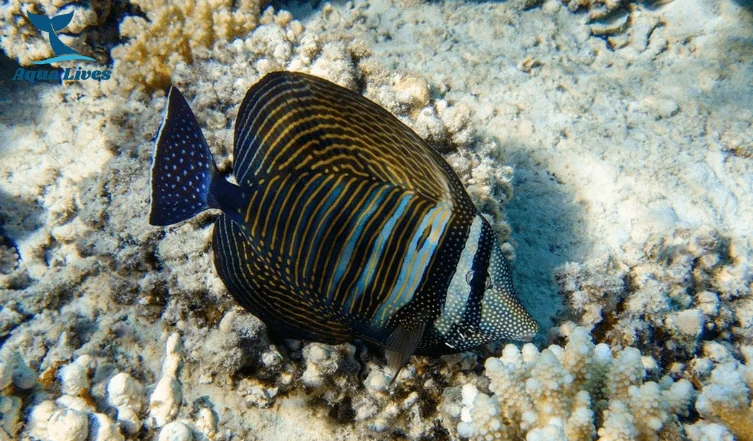Sailfin Tang are popular saltwater fish known for their bright colors and unique fin shape. Aquarium enthusiasts love them for their vibrant look and lively behavior. Their tall, sail-like dorsal fin makes them stand out in any tank. These fish are essential in the aquarium hobby because they help control algae and add beauty to the tank. Sailfin Tangs are attractive and helpful in keeping a balanced and healthy aquarium.
The scientific name for the Sailfin Tang is Zebrasoma veliferum.
Sailfin Tang Origin and Natural Habitat
The Sailfin Tang, which is also known as Veliferum Sailfin Tang, it is type of Surgeonfish which originates from the tropical waters of the Indo-Pacific region, spanning from East Africa to Hawaii and the Marquesas Islands. These vibrant fish are commonly found in coral reefs, lagoons, and outer reef slopes with abundant algae growth. They prefer areas with moderate to strong water currents, where they graze on algae and small invertebrates. Their natural habitat provides ample hiding spots among coral formations and rocks, offering shelter and food sources. This Tang is known for its striking appearance and play a crucial role in maintaining the ecological balance of their reef environments.
Its Appearance
This fish has a robust and elongated body, characteristic of the Zebrasoma genus, known for its streamlined shape and laterally compressed profile. They typically grow quite large, reaching up to 15 inches (38 cm) in length in the wild, making them one of the larger tang species. Their coloration varies depending on location and age, often featuring vibrant colors such as greyish-blue bodies with white and yellow stripes. A notable feature is their prominent dorsal and anal fins, which are large and sail-like, giving them their common name. These fins are often highlighted with bold markings, such as stripes or spots, adding to their distinctive appearance in reef aquariums.
Sailfin Tang Male VS Female
Here are the differences between male and female Sailfin Tang:
- Body Shape: Males tend to have a more elongated and streamlined body shape than females.
- Coloration: Males often exhibit more intense and vibrant colors, especially during breeding seasons, while females may appear slightly duller.
- Dorsal Fin: Male Sailfin Tang typically have more prominent and more pronounced dorsal fins than females.
Tank Requirements for Sailfin Tang
Here are the points for Tank Setup and Care for Sailfin Tang:
- Ideal Tank Size: While 125 gallons is the minimum, a tank of 180 gallons or more is better for an adult Sailfin Tang due to their large size and active swimming habits.
- Water Conditions: Maintain stable conditions with a temperature of 72-78°F (22-26°C), pH between 8.1 and 8.4, salinity around 1.020-1.025, and moderate hardness.
- Substrate and Decoration: Use fine to medium-grain sand substrate to mimic natural reef environments. Include plenty of live rock for grazing and hiding spots.
- Lighting and Filtration: Provide intense lighting to support marine algae growth. Use a robust filtration system suitable for a large saltwater aquarium to maintain water quality and clarity.
Tank Mates for Sailfin Tang
- Suitable Tank Mates:
- Clownfish
- Gobies
- Wrasses
- Blennies
- Other peaceful marine fish
- Fish Species to Avoid:
- Other tangs such as Blue tang to prevent territorial disputes “This is situational if the tank is less than 200 gallons”
- Aggressive fish (like triggers and some larger wrasses)
Sailfin Tang Diet
Omnivorous Diet:
- It eats both plant and animal matter.
Recommended Food Types:
- Marine Algae and Seaweed: Essential for their diet.
- Flake or Pellet Foods: High-quality options formulated for marine fish.
- Occasional Meaty Foods: Brine shrimp or mysis shrimp for variety.
Feeding Schedule and Tips:
- Frequency of Feeding: Feed 2-3 times a day.
- Variety in Diet: Ensure a mix of plant-based and meaty foods.
- Using a Clip for Seaweed: Attach seaweed to a clip inside the tank to allow natural grazing.
Breeding Sailfin Tang
Breeding these Tangs in home aquariums is extremely difficult and rarely successful. Most Sailfin Tangs in the trade are wild-caught or raised in specialized breeding facilities. Here are the key points:
Breeding Behavior:
-
- These Tangs are known to pair up during the breeding season.
- Males may display vibrant colors and perform courtship dances to attract females.
Spawning:
-
- Spawning typically occurs at dusk or night.
- The female releases eggs into the water column, and the male fertilizes them.
- Eggs are miniature and buoyant, floating in the water.
Egg Care:
-
- Eggs hatch within a few days, depending on water temperature.
- Providing a separate breeding tank can help protect eggs from being eaten by other fish.
Fry Rearing:
-
- Once hatched, the fry (baby fish) needs a separate tank with fine filtration to avoid being sucked into filters.
- Feed the fry with rotifers or newly hatched brine shrimp.
- Gradually introduce them to finely crushed flake foods as they grow.
Health and Disease of Sailfin Tang
Taking care of the health of this Tang is crucial for maintaining a thriving aquarium. Here are some key points to ensure their well-being:
Common Diseases and Symptoms:
-
- Marine Ich (Cryptocaryon irritans): White spots on the body and fins, rubbing against objects.
- Velvet Disease (Oodinium): Dusty, gold-like sheen on the body, rapid breathing.
- Lateral Line Disease: Erosion along the lateral line and head, usually due to poor nutrition or water quality.
Prevention Tips:
-
- Quarantine New Fish: Always quarantine new fish before adding them to the main tank to prevent disease spread.
- Maintaining water quality requires regular water changes, proper filtration, and stable water parameters (temperature, pH, salinity).
- Balanced Diet: Provide a varied and nutritious diet to boost the fish’s immune system.
Treatment Tips:
-
- Isolation: Treat infected fish to a quarantine tank without affecting other tank inhabitants.
- Medications: Use appropriate medicines per the diagnosis (e.g. freshwater dips, UV sterilizers, or natural remedies).
- Consistent Monitoring: Regularly observe your fish for any signs of illness and address issues promptly.
Final Words
Sailfin Tang is beautiful and dynamic addition to any marine aquarium. Their vibrant colors and striking fins make them a favorite among hobbyists. With proper care, a suitable tank setup, and attention to their diet and health needs, these fish can thrive and bring joy to any home aquarium. Understanding their specific requirements ensures they live a long, healthy life, contributing to your aquatic environment’s overall beauty and harmony. Whether you are a beginner or an experienced aquarist, these Tangs can be a rewarding choice for your underwater world.

